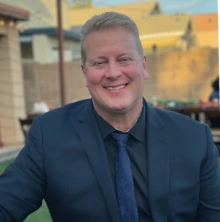How the Server Administration and Security Team Keeps the University Running

When most people think about the technology that powers the University of Arizona, they picture websites, classrooms and email. Few realize there’s an entire world of servers—thousands of them—quietly working behind the scenes to keep those systems alive. That’s where David Gay, Director of Server Administration and Security, and his team come in.

From Air Force to IT Leadership
David’s path to the U of A was anything but linear. A 20-year Air Force veteran, he spent 13 years on active duty, where his IT career began back in the mid-90s.
“I actually started in IT before it was even called IT,” he laughs. When an opportunity opened at the University of Arizona, David jumped at the chance. “I’ve always been a fan of the U of A—my wife and two of my kids went here,” he says. “It felt like the right place to bring everything I’ve learned together.”
Building the Server Administration Team
Leading the Server Administration Team, David oversees the server systems that support the university’s research, academic and business operations. His team manages all on-premises servers—those physical machines distributed across campus buildings. “We’ve made a concerted effort to locate, document, and bring them up to current-day standards,” he says.
The team is organized into pillars aligned with the university’s major domains:
- Research, led by Aaron Cooke, formerly of the Office of Research and Partnerships.
- Academics, led by Elia Nazarenko from the Libraries.
- Health Sciences, managed by Dan Mayhew, previously with Business Affairs.
- Administrative & Auxiliary Operations, led by David Armenta from the College of Engineering, covers everything from the University of Arizona Police Department to the Campus Store and Facilities.
Together, these groups support more than 75 units, each with unique technology environments and needs. “Our server admins are among the best and brightest, incredibly smart, collaborative, and dedicated,” David says. “I couldn’t ask for a better team.”
Standardizing for Security and Efficiency
One of the server administration team’s top priorities is standardization—creating a unified, secure, and efficient server environment. The team is implementing Microsoft SCCM for Windows server management and exploring Enterprise Ansible for Linux systems, ensuring consistent configuration and maintenance across the university.
They're also partnering closely with the Information Security Office (ISO) to improve the effectiveness of the vulnerability management program using Tenable Nessus scanners. As well, they're working with the ServiceNow team on a Configuration Management Database (CMDB) implementation, which will provide valuable insights for server management and strategy. “It’s about being proactive—knowing what’s out there, how it’s configured, and how to respond quickly,” David explains.
Navigating Change and Collaboration
Change is never easy, especially when it touches deeply embedded systems. The server administration team is helping campus units transition away from dozens of unit-managed domains—a complex effort to centralize and strengthen security university-wide. “Some folks are used to managing their own servers and systems, and we understand that,” David says. “But by centralizing and standardizing, we make everyone’s job easier and the university more secure.”
It’s work that takes diplomacy and teamwork. “We’re doing this collaboratively, not by just ‘unplugging things,’” he emphasizes. “It takes coordination across the Chief Technology Office’s specialized services units, and every college and division.”
Looking Ahead
A year from now, David envisions measurable progress: more centralized server management, cleaner data in ServiceNow, and fewer isolated systems running on their own. “We’ve got great people and great ideas. The challenge is big, but so is the opportunity.”
Asked what makes him most proud, David doesn’t hesitate. “The people. Every member of this team is sharp, committed, and collaborative. They care deeply about doing the right thing—for the university and for each other.”

